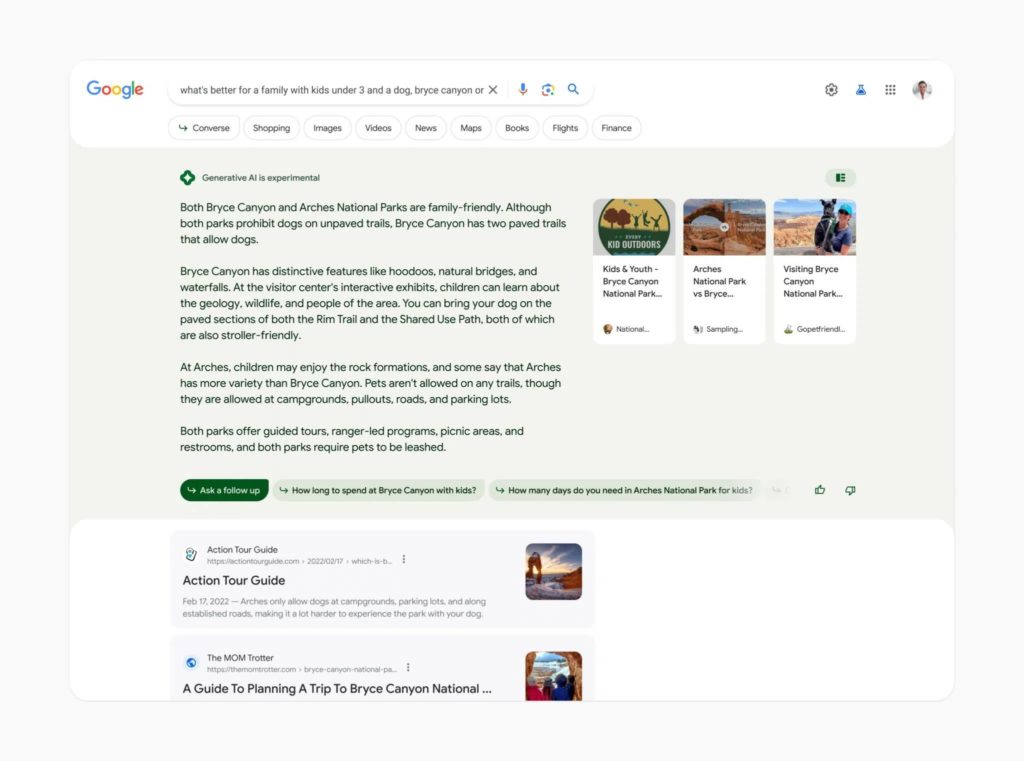Google has recently launched its groundbreaking AI-powered search engine, which operates under the code name “Magi” This innovative platform promises to revolutionize the search experience, offering users a more visual, bite-sized, personalized, and human touch.
However, access to this cutting-edge technology is currently limited to a select group of users. To experience Google’s new Search Generative Experience (SGE), interested individuals must join a waitlist through Google Labs. Please note that due to high demand, it may take several weeks before you can personally engage with this remarkable tool.
A Look at the Interface of Google’s New Search Generative Experience
Within the Search Generative Experience (SGE) interface, Google incorporates an intriguing feature that showcases an AI-generated answer positioned above the search results. To ensure transparency, Google explicitly identifies this answer as an outcome of experimental Generative AI. Following this label, users can find a response tailored to their query.

The answer is presented within a distinct box, accompanied by references to the websites that were utilized in generating the response. These referenced websites are clickable, allowing users to delve deeper into the information provided. Alternatively, users have the option to pose additional questions or explore further by utilizing the toggle button located at the top right corner.
According to Google, this innovative approach provides users with an AI-powered snapshot of vital information to consider, empowering them to make informed decisions. The embedded links enable users to explore the subject matter in more depth, enhancing their research and understanding of the topic at hand.
Google incorporates clickable boxes with images in its AI-generated answers to provide users with direct access to relevant websites for further information.
Google has implemented a dynamic feature where the color of the generative AI answer box adjusts based on the specific journey types and the intent behind the user’s query. This color variation helps users quickly identify the nature of the information and the purpose it serves in addressing their query.
Conversations
Users can also follow up with your query by adding more details or additional prompts to the “Ask a follow-up” box. Google will then generate a follow-up answer
“Context will be carried over from question to question, to help you more naturally continue your exploration. You’ll also find helpful jumping-off points to web content and a range of perspectives that you can dig into,” Google explained.
Conversational mode is especially useful for follow-up questions, as well as more complex or evolving information journeys, Google explained.
“It uses AI to understand when a person is searching for something that is related to a previous question. It carries over context from previous questions to reformulate the query to better reflect the intent,” Google added.
Google’s Approach: Google has a five-point approach to generative AI in search
Information Needs: How can Google reduce the number of steps it takes for the searcher to accomplish a task or complete a goal, and how can Google make the experience more fluid and seamless?
Information Quality: The information the search engine responds with needs to be of high quality, and the way the AI responds needs to be at a high level. Should Google answer health or financial-related queries?
Safety Constraints: Should Google provide first-person responses? Should Google provide fluid answers that users would trust to be 100% accurate, when Google might not be able to verify the accuracy of all the answers?
Ecosystem: Google wants to provide traffic and credits to the source of the content. Google wants to design an experience that encourages users and searchers to dig deeper into those sources.
Ads: Can ads be relevant and provide additional information to the user, and how is it best to show the ads to the user in this experience.
Google SGE offers a unique search experience that is quite different from what we’ve seen before, yet it still retains the familiar feel of traditional Google search. – just say if there is any grammatical or spelling error or not













